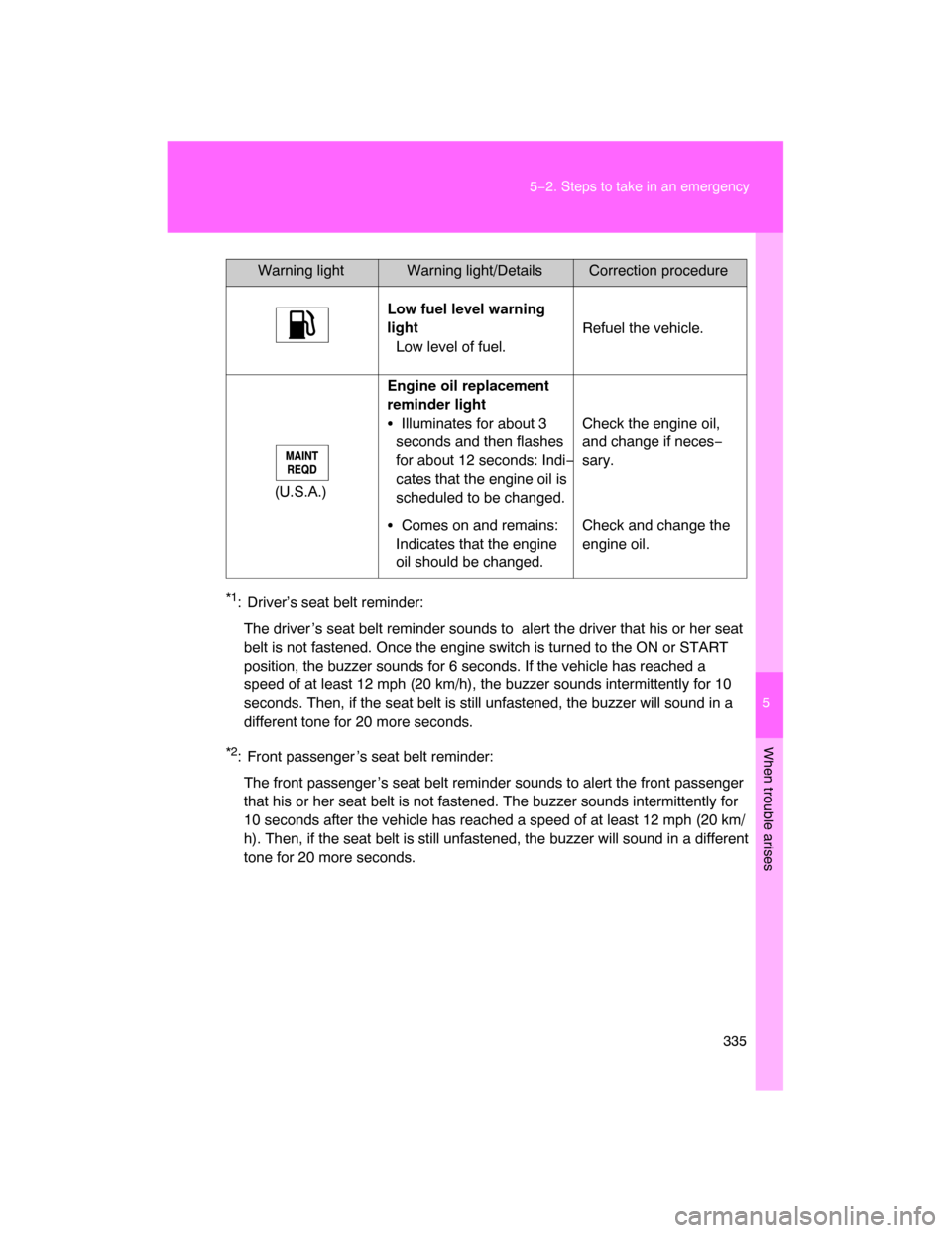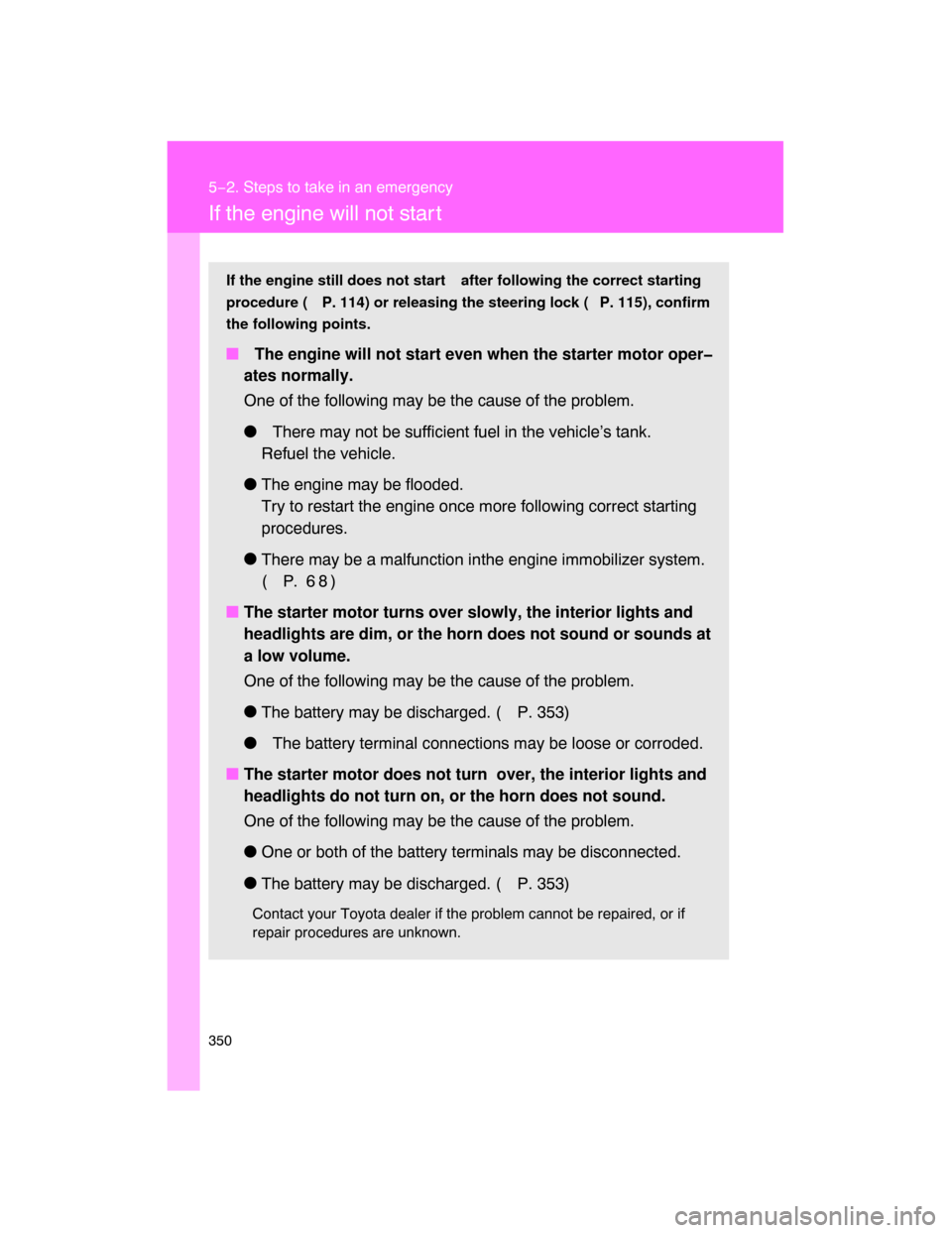Page 323 of 400
328
5−1. Essential information
Fuel pump shut off system
Follow the procedure below to restart the engine after the system is
activated.
Turn the engine switch to the ACC or LOCK position.
Restart the engine.
NOTICE
� Before starting the engine
Inspect the ground under the vehicle.
If you find that fuel has leaked onto the ground, the fuel system has been
damaged and is in need of repair. Do not restart the engine.
To minimize the risk of fuel leakage when the engine stalls or an air�
bag inflates upon collision, the fuel
pump shut off system stops sup�
plying fuel to the engine.
Page 330 of 400

5
When trouble arises
335 5−2. Steps to take in an emergency
*1: Driver’s seat belt reminder:
The driver ’s seat belt reminder sounds to alert the driver that his or her seat
belt is not fastened. Once the engine switch is turned to the ON or START
position, the buzzer sounds for 6 seconds. If the vehicle has reached a
speed of at least 12 mph (20 km/h), the buzzer sounds intermittently for 10
seconds. Then, if the seat belt is still unfastened, the buzzer will sound in a
different tone for 20 more seconds.
*2: Front passenger ’s seat belt reminder:
The front passenger ’s seat belt reminder sounds to alert the front passenger
that his or her seat belt is not fastened. The buzzer sounds intermittently for
10 seconds after the vehicle has reached a speed of at least 12 mph (20 km/
h). Then, if the seat belt is still unfastened, the buzzer will sound in a different
tone for 20 more seconds.Low fuel level warning
light
Low level of fuel.Refuel the vehicle.
(U.S.A.)Engine oil replacement
reminder light
�Illuminates for about 3
seconds and then flashes
for about 12 seconds: Indi−
cates that the engine oil is
scheduled to be changed.Check the engine oil,
and change if neces−
sary.
�Comes on and remains:
Indicates that the engine
oil should be changed.
Check and change the
engine oil.
Warning lightWarning light/DetailsCorrection procedure
Page 331 of 400

336 5−2. Steps to take in an emergency
� Key reminder buzzer
The buzzer indicates that the key has not been removed (with the engine
switch in the ACC or LOCK position and the driver ’s door opened).
� If the malfunction indicator lamp comes on while driving
First check the following:
�Is your vehicle low on gas?
If it is, refuel the vehicle immediately.
� Is the fuel tank cap loose?
If it is, tighten it securely.
The light will go off after taking several driving trips.
If the light does not go off even after several trips, contact your Toyota dealer
as soon as possible.
� Front passenger detection sensor and passenger seat belt reminder
If luggage or other load is placed on the front passenger seat, depending on
its weight, the reminder light to flash and buzzer to sound.
�
When the tire pressure warning light comes on
Check the tire inflation pressure and adjust to the appropriate level.
�The tire pressure warning light may turn on due to natural causes
The tire pressure warning light may turn on due to natural causes such
as natural air leaks or tire inflation pressure changes caused by temper−
ature. In this case, adjusting the ti
re inflation pressu re will turn off the
warning light after a few minutes.
�When a tire is replaced with a spare tire
The spare tire is also equipped with the tire pressure warning valve and
transmitter. The tire pressu
re warning light will turn on if the tire inflation
pressure of the spare tire is low. If a tire goes flat, even though the flat
tire is replaced with the spare tire, the warning light does not turn off.
Replace the spare tire with the repair
ed tire and adjust the proper tire
inflation pressure. The ti re pressure warn ing light will turn off after a few
minutes.
Page 333 of 400

338 5−2. Steps to take in an emergency
CAUTION
�Maintenance of the tire
Each tire, including the spare (if provided), should be checked monthly
when cold and inflated to the inflation pressure recommended by the
vehicle manufacturer on the vehicle
placard or tire inflation pressure
label (tire and load information label). (If your vehicle has tires of a differ−
ent size than the size indicated on the vehicle placard or tire inflation
pressure label [tire and load information label], you should determine the
proper tire inflation pr
essure for those tires.)
As an added safety feature, your
vehicle has been equipped with a tire
pressure monitoring system (TPMS−ti re pressure warning system) that
illuminates a low tire pressure telltal e (tire pressure warning light) when
one or more of your tires is significantly under−inflated. Accordingly,
when the low tire pressu
re telltale (tire pressure warning light) illumi−
nates, you should stop and check your tires as soon as possible, and
inflate them to the proper pressure. Driving on a significantly under−
inflated tire causes the tire to overheat and can lead to tire failure.
Under−inflation also reduces fuel effi
ciency and tire tread life, and may
affect the vehicle’s handling and stopping ability.
Please note that the TPMS (tire pressure warning system) is not a sub−
stitute for proper tire main tenance, and it is the driver ’s responsibility to
maintain correct tire pressure, even if under−inflation has not reached the
level to trigger illu
mination of the TPMS low ti re pressure telltale (tire
pressure warning light).
Your vehicle has also been equipped with a TPMS (tire pressure warning
system) malfunction indicator to indi cate when the system is not operat−
ing properly. The TPMS (tire pressure warning system) malfunction indi−
cator is combined with the low tire pressure telltale (tire pressure
warning light). When the system det
ects a malfunction, the telltale will
flash for approximately one minute an d then remain continuously illumi−
nated. This sequence will
continue upon subsequent vehicle start−ups as
long as the malfunction exists. When the malfunction indi cator is illumi−
nated, the system may not be able to detect or signal low tire pressure
as intended.
Page 345 of 400

350
5−2. Steps to take in an emergency
If the engine will not star t
If the engine still does not start after following the correct starting
procedure ( P. 114) or releasing the steering lock ( P. 115), confirm
the following points.
� The engine will not start even when the starter motor oper�
ates normally.
One of the following may be the cause of the problem.
� There may not be sufficient fuel in the vehicle’s tank.
Refuel the vehicle.
�The engine may be flooded.
Try to restart the engine once more following correct starting
procedures.
�
There may be a malfunction inthe engine immobilizer system.
(P. 6 8 )
�
The starter motor turns over slowly, the interior lights and
headlights are dim, or the horn does not sound or sounds at
a low volume.
One of the following may be the cause of the problem.
�
The battery may be discharged. ( P. 353)
� The battery terminal connections may be loose or corroded.
�The starter motor does not turn over, the interior lights and
headlights do not turn on, or the horn does not sound.
One of the following may be the cause of the problem.
�
One or both of the battery terminals may be disconnected.
�
The battery may be discharged. ( P. 353)
Contact your Toyota dealer if the problem cannot be repaired, or if
repair procedures are unknown.
Page 356 of 400
362
6−1. Specifications
Maintenance data (fuel, oil level, etc.)
Dimensions and weight
*: Unladen vehicle
Overall length 183.9 in. (4670 mm)
Overall width 75.0 in. (1905 mm)
Overall
height*2WD models 71.3 in. (1810 mm)
4WD models 72.0 in. (1830 mm)
Wheelbase 105.9 in. (2690 mm)
Front tread 63.2 in. (1605 mm)
Rear tread 63.2 in. (1605 mm)
Vehicle capacity weight
(Occupants + luggage)
1190 lb. (540 kg)
Towing capacity
(Trailer weight + cargo)
5000 lb. (2265 kg)
Page 358 of 400
364 6−1. Specifications
Engine
Fuel
Model 1GR−FE
Type 6−cylinder V type, 4−cycle, gasoline
Bore and stroke 3.70 3.74 in. (94.0
95.0 mm)
Displacement 241.4 cu.in.(3956 cm
3)
Drive belt tension Automatic adjustment
Fuel type Unleaded gasoline only
Octane rating 91 (Research octane number 96) or higher
Fuel tank capacity
(Reference)
19.0 gal. (72.0 L, 15.8 lmp.gal.)
Page 359 of 400
365
6−1. Specifications
6
Vehicle specifications
Lubrication system
*: 5W−30 is an oil that provides optimal levels of fuel efficiency.
Oil viscosity
�
The 5W portion of the oil viscosity rating indicates the characteristic
of the oil which allows cold startab ility. Oils with a lower value before
the W allow for easier starting of the engine in cold weather.
� The 30 in 5W−30 indicates the oil
viscosity when the oil is at its
operating temperature. An oil with a higher viscosity may be better
suited if the vehicle is operated at high speeds, or under extreme
load condition.
Oil capacity
drain and refill
(Reference)
With filter
Without filter5.5 qt. (5.2 L, 4.6 Imp.qt.)
5.2 qt. (4.9 L, 4.3 Imp.qt.)
Oil grade ILSAC multigrade engine oil
Recommended oil
viscosity
Use Toyota approved “Toyota Genuine Motor
Oil” or equivalent to satisfy the grade and
viscosity shown below.
Outside temperature